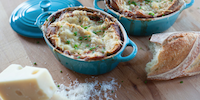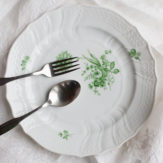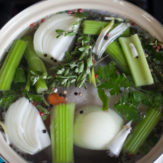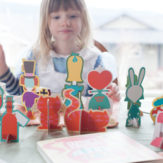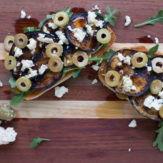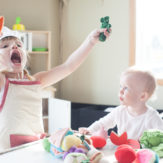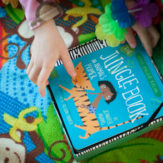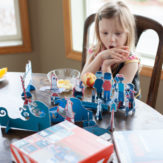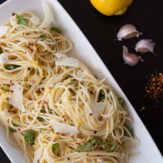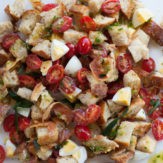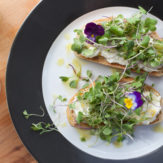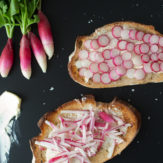 PIN
PIN
I had a Q &A planned for this week as a follow up to my post about French Kids Eat Everything, but I couldn’t answer all of the questions on my own so I sent the author, Karen, an email to see if she’d like to participate! So here you have my answers along with advice from French Kids Eat Everything author Karen Le Billon, and my sweet cousin Aurélie who lives just outside of Paris with her two girls! Thank you for all your great questions! We are giving away a copy of French Kids Eat Everything… see the end of the post to see how to enter!
GENERAL:
THE FRENCH APPROACH SEEMS REALLY OVERWHELMING. WHAT’S THE BEST WAY TO MAKE THESE MAJOR CHANGES?
Kacie: My advice would be to start with one of the “rules” at a time. Start small – cut out snacks, then move on to the next rule. For us we really did a major overhaul all at once and that worked great for us, but it you feel overwhelmed give yourself, and your children time to adjust bit by bit. Karen’s book really chronicles her journey of reforming her kids’ eating habits over time… it’s a process that you can approach step by step.
HOW IMPORTANT IS IT TO READ KAREN’S BOOK?
Kacie: I would highly recommend reading it. While I have a lot of information from the book/my experience on the blog, it’s just my opinion. Her book is a best-seller for a reason! It’s well written, honest, encouraging and inspirational. (We are giving away a copy today… you can enter below!)
WHAT DOES A TYPICAL FAMILY MEAL LOOK LIKE IN YOUR HOME?
Karen: Three courses: a simple vegetable starter, a main course (usually a ‘starch’ like rice, potatoes, couscous or quinoa; a protein (fish, or lentil soup are current favorites), and another vegetable (whatever is in season); fresh fruit for dessert.
Kacie: We sometimes have a vegetable starter (I’m working on making this more consistent. If it’s a new veggie we serve it first to encourage Gigi to eat it or try it). We then have a main course in which I try to include a protein, a vegetable, and sometimes a carbohydrate. Depending on how dinner goes, we will have some yogurt with jam, a piece of fruit, a little piece of chocolate or ice cream for dessert. We always have water to drink with dinner. I never serve milk at meals.
Aurélie: a starter which could be a soup, raw endives, grated carrots, … (in winter time) or tomatoes, cucumber, melon, … (in summer time)
a main meal : spinach and cream and prosciutto, pasta and ham, cauliflower with béchamel sauce and eggs, …
and a dessert : yogurt, home made cake, chocolate porridge, rice pudding, fruits, …
and WATER …
DO YOU FEED YOUR KIDS ON A SCHEDULE?
Karen: Yes! Three meals per day, and one healthy afterschool snack around 4 pm. No random snacking otherwise.
Kacie: Yes. our daily schedule is…
7:30 breakfast
12:00 lunch
3:30 small snack and 1/2 cup milk
6:00 dinner (bedtime is at 7:30pm)
Aurélie: We try do make them eat between 19h30 (7:30pm) and 20h (8pm) every night but we do not respect it when we have guests (once a week !) at noon, during the week, the canteen (school cafeteria) is quiet on schedule but during the weekend they eat between 12h and 14h.
IS IT WISE TO NEGOTIATE WITH YOUR CHILD AT THE TABLE?
Karen: French Food Rule #1: Parents are in charge. This means no bribing, threatening, or negotiating. Gentle encouragement is fine (and fun)! A simple way to think about it: Parents decide when meals are served, as well as what is served. Kids can decide whether and how much to eat. No substitutes or short-order cooking. That way, kids gradually learn to try everything on their plates, and also learn they can’t whine to get alternatives. Remember: they won’t starve with this approach. If they don’t eat a lot at one meal, they’ll eat more at the next.
FEEDING BABIES:
DO YOU FOLLOW THE FRENCH KIDS APPROACH FROM THE START?
Karen: It helps if you do so, and that is what French parents do.
Kacie: With Gigi we did not, but I sure wish we had. We got stuck on rice/oat cereal, purées, and too much formula/milk. It was kind of a nightmare. We will definitely be skipping the cereals this time and are planning to try to find a balance between purées and the Baby Led Weaning approach. If you have a tiny babe at home right now, start the French Way and then it will be easy. I loved the advice “start as you mean to go on”. With Gigi we followed this in everything expect our introduction of food – which is really the only area that we had trouble with.
Aurélie: Here in France, we’ve been applying this way of eating for our first daughter (and now our second) since she was born. If my memory is right, our older daughter has been eating the same thing as us since she was 9 months old. First we mixed our food, then we squished it and after gave her small pieces … For our younger daughter, we gave her some pieces before she got her teeth… no matter, her gums were strong enough (if you doubt, put your finger inside your baby’s mouth and you’ll see!)
WHEN THEY WERE BABIES DID YOU GIVE THEM SINGLE FOODS (JUST APPLES OR SQUASH) OR WERE THE PUREES ALWAYS MIXES OF DIFFERENT FOODS?
Karen: Single foods to start with, and then mixes of different foods. French parents tend to be very adventurous in trying different mixes of flavors. For example, French Kids Eat Everything has a great recipe for pear-leek puree. Trust me, it’s delicious!
Aurélie: No rule, it depends on our desire, on what is in the fridge but the main rule is that we cook the same thing for them than for ourselves. Maybe if you want to introduce a new food, introduce it with one your baby loves … so you can switch from one to the other. (one spoon of this, one spoon of that ….)
WHAT ARE YOUR THOUGHTS ON BABY LED WEANING (no broths/purées)?
Karen: This may work for some children who are developmentally ready to chew at an early age. But not all children will be ready so early (my second child had her teeth come in very late, and was slow to learn to chew). So baby-led weaning may work for some babies, but purées may work for other babies. However, ‘graduating’ them to solids as soon as they are able to handle them is a great idea–for tooth development as well as acquiring ‘eating skills’. The key to the French approach is maximum exposure to different flavors at an early age. It’s fun for babies!
VARIETY:
ANY HELPFUL HINTS ABOUT HOW TO ENCOURAGE KIDS TO TRY A BIT OF EVERYTHING ON THEIR PLATE?
Karen: Serve small portions and treat it as an ‘experiment’ rather than forcing them to eat everything on their plate. Ask them to describe the food – not just react with ‘yuck’. My new book (Getting to Yum, which will be published with HarperCollins in 2013) has a detailed set of suggestions for how to do ‘Taste Tests’ with children.
Kacie: We always ask Gigi to try everything. We gently (not forcefully) ask, “did you taste your _____?” Sometimes a taste is a lick, a tiny bite… we don’t judge her process of tasting and testing. It’s taken a while for her to embrace trying everything. I feel like a lot of it is about her learning to trust us at the table. The older she gets the easier it is to get her to embrace the process. We can talk about foods more, and she gets excited about tasting new foods.
Aurélie: Sometime we arrange the food in the plate to make it looks like something funny or nice.
DID YOU FIND YOUR KIDS GOT BETTER/BRAVER AT TRYING NEW THINGS AS YOU WENT ALONG IN THIS PROCESS?
Karen: Definitely! They began to define themselves as ‘good eaters’ and ‘adventurous eaters’, and were always willing to try.
Kacie: Yes! Last night I served artichokes and I wasn’t sure how she’d embrace them but she loved it! She got to eat with her hands and dip the leaves in aioli. Sometimes I’m surprised by what she’ll eat! Part of it has been setting aside my own judgements about what I think she will or won’t eat. I think here in the U.S. we are taught to believe that kids won’t eat/like certain things, and the further we get along in this process, I’m finding that’s simply not true!
DID YOU FIND IF YOU KEPT PUTTING NEW FOODS IN FRONT OF YOUR CHILD ENOUGH TIMES THEY WOULD EVENTUALLY TRY IT?
Karen: Yes. Mostly. But kids also have natural food preferences (as do adults) which must be respected. If there are one or two foods they don’t like, that’s OK. They can try them from time to time, to check.
Kacie: It’s also taken a long time for her to embrace squash and potatoes but she loves them now. There were definitely some very frustrating meals/weeks where I felt that she’d never eat something, but eventually she did and it was all the more rewarding for having continued to put the effort into it.
WHAT DO I DO IF MY CHILD HAS A PARTICULARLY STRONG AVERSION TO A SPECIFIC FOOD? FOR EXAMPLE, POTATOES, OR PROTEINS, RAW VEGETABLES vs. COOKED VEGETABLES? DO I SERVE IT ONLY IN THE FORM I KNOW THEY’LL EAT IT OR DO I KEEP TRYING DIFFERENT APPROACHES? ANY CREATIVE IDEAS HERE FOR TASTING FOODS IN VARIOUS FORMS?
Karen: For older kids, keep serving it in different forms. Vary the texture (softer is better for meat, for example). Try fun games! Getting to Yum has lots of these (for example – creating ‘potato volcanoes’ works wonders!).
HOW IMPORTANT IS IT TO ALWAYS SERVE SOMETHING THAT KIDS LIKE ALONG WITH NEW FOODS?
Karen: Very important. It reassures them. And scientific research shows that the ‘favorite flavor’ tactic actually creates positive associations with the new food. Limit quantities of the favorite food, though.
WHAT IF MY CHILD ONLY FOCUSES ON THE FOOD THEY LIKE, OR CARBOHYDRATES AND STAY AWAY FROM THE NEW FOODS? IF THEY KEEP FILLING UP ON THAT ONE THING DO YOU CONTINUE TO SERVE THEM THAT FOOD OR TELL THEM THEY MUST TRY THE OTHER FOODS TOO?
Karen: See above – limit quantities of the favorite foods to reasonable portions. Kids have to at least taste the new food before getting more servings of other foods.
Kacie: We tell Gigi she needs to eat some of everything before she has more pasta, for example. When she’s eaten more of her other foods, we will give her a little more pasta… but only a little bit. We try to keep it really balances. Also, I do limit the quantity of pasta or bread on her plate to start off with. I know she’ll start by eating that so I don’t want her to fill up on it. Since we ask her to eat 2-3 bites of everything, I only give her 2-3 bites of pasta along with the other food. We also try to follow the same rule ourselves!
Aurélie: We teach our older daughter to finish the dish with what she likes best. She also has to finish her plate before having some more pasta for example.
HOW DO YOU ENCOURAGE TASTING/TRYING WITHOUT CROSSING THE LINE INTO A TODDLER BATTLE ZONE/POWER STRUGGLE?
Karen: Good question! Adults should taste the food first, with pleasure (scientific studies show this really works)! And then make it clear your child has a choice, and never force. Most importantly, don’t react if they refuse. If you don’t, then there is no power struggle. Your kids should quickly give up antics at the table.
Kacie: I always try to keep in mind that we don’t want to have a power struggle so we never make her do/eat anything. If she says no to something we don’t make a big deal out of it. We eat it and show her how delicious or fun it is to eat, but we don’t try to draw a ton of attention to it. She’ll usually give a try at some point throughout the meal.
DO THEY REFUSE FOODS SOMETIMES?
Karen: Yes! The best response is no fuss or stress on the part of the parent. Rather, you should share your optimism that they will eventually learn to like it, and praise them (but not too much) when they do.
Kacie: Yes. Often. But she’ll usually give it a taste or try. She’s starting to learn that she needs to taste it in order to have the next course (dessert).
Aurélie: They refuse food, but they always have to taste.. Children have to eat 3 forks (to taste) if they want to have the dessert. If they don’t want to eat, the meal stops and they go out of the table (It is possible for us because this happens rarely)…. but for toddlers it’s more complicated, we give them the rest of the meal (and bread to compensate) and try it at another time.
HOW LONG SHOULD I EXPECT MY CHILD TO SIT AT THE TABLE?
Karen: As a rule of thumb, toddlers can sit for at least 5 minutes, preschoolers for 10 minutes, primary school children for 15 minutes. Getting to Yum has lots of great ideas for extending ‘table time’ in a fun way.
Kacie: Gigi starts to get anxious after 15-20 minutes. We tell her she can get down and play but we are still eating. She has to entertain herself while we finish dinner. In the beginning we forced her to stay at the table until everyone was done and it was pretty challenging. If we are at a restaurant she has to stay in her chair and we bring coloring stuff for her, or a book.
Aurélie: They sit at the table for 20 minutes, time for them to eat all the menu.
AT WHAT AGE DO YOU THINK KIDS CAN TRULY UNDERSTAND THE CONCEPT OF “IF I EAT THIS, I ALSO GET TO HAVE THIS/MORE OF THAT?”
Karen: Right from the start! Toddlers are good at logical consequences, and food is a great way to learn this at a young age.
DO YOU ALWAYS MAKE YOUR KIDS EAT THE SAME THING YOU’RE EATING AT BREAKFAST AND LUNCH, OR PRIMARILY AT DINNER?
Karen: They eat what we eat, at every meal. It’s never a problem, because it’s our family habit. They don’t even question it!
Kacie: I’m working on this. Often Gigi’s breakfasts and snacks are different from what we are eating. We always try to sit with her during these meals. I eat lunch with her, and we all eat dinner together as a family. I think it’s mostly about consistency.
MANNERS:
DOES MY CHILD GET TO DECIDE WHEN THEY’RE DONE EATING? WHAT IF THEY HAVEN’T TRIED EVERYTHING ON THEIR PLATE?
Karen: Our kids sit with us until everyone has finished their main course. They always have to try everything on their plate. If they finish dessert earlier, they can ask to be excused. But we encourage them to stay at the table with us until everyone is finished.
Kacie: We ask Gigi to stay at the table until we are done with the main course, but sometimes she is all done. If she asks to be excused we will let her get down and play. If we are having dessert she has to stay at the table and wait while we finish our dinners. If she chooses to leave the table, she is not allowed to come back for more grazing/dessert. When she’s done, she’s done.
WHAT DO YOU DO TO ADDRESS BAD MANNERS/BEHAVIOR AT THE TABLE? FOR EXAMPLE, STANDING UP IN THEIR CHAIR, THROWING FOOD ON THE FLOOR?
Karen: For throwing food: the food is removed, and the meal is over. If you follow through on this consistently, it only takes one or two tries for them to get the message, and to nip this behavior in the bud.
Kacie: Gigi sometimes throws a handful of food on the floor to let us know she’s done. We make her get down and clean it up, then get back in her chair and ask to be excused. We remind her that that is not the way to let us know she’s done.
Aurélie: My 2 girls love eating, so when they do something bad, like throwing food or getting up on their baby chair, we confiscate the food until they have seated or they have cleaned up the floor (we do that even with Chloe who is 16 months, but don’t expect to have a clean floor!)
DESSERT:
DO YOU LET YOUR KIDS HAVE DESSERT IF THEY DIDN’T TRY EVERYTHING ON THEIR PLATE?
Karen: Our French Food Rule is: ‘You don’t have to like it, but you do have to try it!” It’s ingrained, so they always do.
Kacie: No. If we are having dessert I’ll remind her that she needs to taste everything before she can have dessert. We’ll ask her, “Did you taste that ____? If you’d like to have dessert, you need to eat some of it.” I try to look at it as a natural consequence as opposed to a bribe. She has the choice.
Aurélie: We have to blackmail a little bit! “Mum can I have a chocolate?” “Yes after your pear!”
WHAT DO YOU DO WHEN YOUR KIDS NEGOTIATE WITH YOUR OVER “HOW MUCH OF THIS DO I NEED TO EAT TO GET DESSERT”?
Karen: I serve small portions (small kids need to eat smaller quantities than we often think) so this is rarely an issue. A general rule of thumb: one spoon/bite for every year of age (up until school age, when this shouldn’t be an issue anymore).
HOW DO YOU HANDLE CHILDREN OF MULTIPLE AGES AT ONE TABLE? IF ONE CHILD EATS EVERYTHING, AND THE OTHER CHILD DOES NOT, DO BOTH KIDS GET TO HAVE DESSERT? NEITHER OF THEM?
Karen:
Each child gets their own ‘logical consequences’ of their actions, and lives with them. Just like in real life!
Kacie: If we are eating with friends, we make sure to let Gigi know that if she chooses to be done, or doesn’t try everything, she won’t get to have dessert with everyone else. Sometimes she makes the choice to skip dessert! I think the key is that the power is in her hands.
SOCIAL:
HOW DO YOU HANDLE SOCIAL ASPECTS THAT ARE DIFFERENT HERE THAN IN FRANCE? FOR EXAMPLE, GRANDPARENTS, FRIENDS, NEIGHBORS SPOILING KIDS WITH TREATS, SNACKS, JUNK FOOD, AND FEEDING THEM OUTSIDE OF MEAL TIMES?
Karen: I politely explain to the kids that if they are handed a treat, they can save it for dessert at their next meal. They now follow this routine happily.
Kacie: If someone gives Gigi a treat, I will tell her she can have it for her snack after her nap, and I put it away. When we are at a friend’s house, I let her follow the rules at that house… unless it’s close to a mealtime in which case I say no to any snacking. For long family trips, Kyle and I discuss what will be the best approach for the trip – let go of the rules for a few days, stick to the rules as if we were at home… depends on the trip/holiday/event. We try to remember that food is social, and there are some things we can participate in for a short time because we have set up our foundation of good eating at home and we know we will return to it.
HOW DO YOU HANDLE HAVING GUESTS OVER FOR DINNER OR EATING OUT? MY CHILD SEEMS TO HAVE MUCH WORSE BEHAVIOR WHEN WE HAVE COMPANY OR ARE OUT TO DINNER? DO YOU STICK FIRMLY TO YOUR RULES EVEN IF IT RESULTS IN A MELTDOWN?
Karen: My kids love having people over, as we usually have special meals with things they love to eat. So they tend to behave better. I do make sure to gently remind them how to behave before our guests come over. And sometimes we have a little fun time after the meal (for example, they get to stay up a bit later). Finally, I make sure to serve at least one thing they like at the meal, and not to fuss over their food choices. It’s my job to serve the food, their job to eat it and behave–which they do. I find if I don’t focus too much on them, but rather on my guests, things go more smoothly.
Kacie: Gigi loves having company over. She often eats less when other kids are over because she wants to play. We’ve noticed that she’ll be done when her friend(s) are, even if she hasn’t eaten much. Sometimes we’ll give her a glass of milk at bedtime on these days to supplement. When it’s all adults, she actually tends to eat more! We just recognize it’s not the norm and go with the flow, knowing we will return to our normal eating habits the next day. For behavior we require the same manners from her as when no one is there. If our friends witness a tantrum or meltdown, so be it. Eating out can be a bit of challenge too but it’s getting easier… it’s all about sticking to our behavior rules. It’s natural for kids to test boundaries when things are different.
Aurélie: When we are eating with friends and that for sure the meal is going to last, we give the same meal as us to the kids before we eat ourselves. Then they can play and we can eat peacefully!
CONSISTENCY:
WHAT IF YOU ONLY SPEND HALF (OR LESS) OF YOUR MEALS WITH YOUR CHILD? DO YOU HAVE ADVICE FOR HANDLING THE DIFFERENCES BETWEEN A PRESCHOOL/DAYCARE (EAT ON DEMAND/MINIMAL ADULT SUPERVISION) AND HOME (THE FRENCH APPROACH)? WHAT ABOUT MULTI-HOME INCONSISTENCIES?
Karen: Good question. Breakfast and dinner are both good learning occasions. It’s hard to enforce behavior at daycare, so I wouldn’t try to single out one child. But the preschool may be receptive to new approaches for all the kids. One preschool in New York, the Alphabet Academy, was so excited about the ‘Getting to Yum’ approach that they tried out ‘taste training’ for all of their kids–which helped them try lots of new foods. So perhaps giving a copy of ‘French Kids Eat Everything’ or ‘Getting to Yum’ to the preschool/daycare will help them see how they could make changes.
Kacie: I think getting others (your school our your spouse) to participate would be great! But ultimately you can only control what happens in your house at your table. I was a nanny for 10+ years and found that the kids would respect rules with me that they would often ignore with their parents because I was really consistent on certain things. Your kids will learn what your rules are vs. someone else’s rules (or lack of rules). Kids are really smart!
FINAL THOUGHTS:
ANYTHING ELSE YOU’D LIKE TO ADD?
Karen: My final message: There’s hope!! You can really make a positive change at the family table.
Kacie: This is definitely a process, it is sometimes challenging but overall it’s incredibly rewarding. We spend so much of our time eating as a family and it should be fun, enjoyable, and wonderful. It’s so worth the effort!
Auríelie: Food has to be good, to change one time from another, to involve kids into cooking, … eating with our kids has always been a pleasure even if it’s a lot of care and time.
WHAT IS YOUR FAVORITE PART ABOUT EATING AS A FAMILY?
Karen: Mealtime chats – which are the highlight of my day. When eating is going smoothly, the family is free to focus on telling stories, sharing ideas, and having fun together –which brings a family closer together. Meals are a highlight of the day rather than a source of stress (which was not always the case in our household).
Kacie: I love everything about it! The older Gigi gets, the more fun it is. She has so much to contribute to conversations… sometimes we spend the whole meal giggling. I truly look forward to our family dinners every single day.
Aurélie: Eat together …no ? It has always been like that, so I have never imagine something else.
There you have it! I hope these answers to your questions help you on your family’s journey to enjoyable eating!
.jpg)
.jpg) Nuna sent us our stroller and our travel cot (that Roux still sleeps in every night) just before he was due. They’d reached out at a time when I was feeling so unsettled – not sure what to do with all that nesting anxiety because we didn’t have anything for Roux. Those packages arriving on our doorstep, giving me something to assemble, brightened our experience here so much. So when they offered to send a high chair, I said, “Yes, please!” It’s so odd, this living abroad while have a baby thing. There are these amazing moments where it feels like we’re on a great adventure – and then there are these other moments where I feel sad that he’s not having his baby days in our “real” home and sleeping in the same crib or eating in the same high chair his sisters did. So having his own, very nice, very special stroller, cot, or high chair means so much to a sensitive, sentimental mama like me.
Nuna sent us our stroller and our travel cot (that Roux still sleeps in every night) just before he was due. They’d reached out at a time when I was feeling so unsettled – not sure what to do with all that nesting anxiety because we didn’t have anything for Roux. Those packages arriving on our doorstep, giving me something to assemble, brightened our experience here so much. So when they offered to send a high chair, I said, “Yes, please!” It’s so odd, this living abroad while have a baby thing. There are these amazing moments where it feels like we’re on a great adventure – and then there are these other moments where I feel sad that he’s not having his baby days in our “real” home and sleeping in the same crib or eating in the same high chair his sisters did. So having his own, very nice, very special stroller, cot, or high chair means so much to a sensitive, sentimental mama like me..jpg)

 Introducing Roux to solid foods has been really fun. When the girls were his age they hardly showed any interest in food at all, preferring to nurse the days away. But this boy is so into his food that for a couple (rather unpleasant) weeks there he would sit in his high chair and shriek at us while we rushed to make him food… now he seems to understand that, if he’s in his chair, we are going to feed him and he can relax. That, or the fact that once he’s in his chair he has two big sisters who rush to grab him a handful of Cheerios.
Introducing Roux to solid foods has been really fun. When the girls were his age they hardly showed any interest in food at all, preferring to nurse the days away. But this boy is so into his food that for a couple (rather unpleasant) weeks there he would sit in his high chair and shriek at us while we rushed to make him food… now he seems to understand that, if he’s in his chair, we are going to feed him and he can relax. That, or the fact that once he’s in his chair he has two big sisters who rush to grab him a handful of Cheerios.

 We started off trying a bit of Baby Led Weaning, but his choking and gagging freaked us out too much so we went back to our trusted French Kids Eat Everything approach. I bought an inexpensive immersion blender on Amazon and started making him some purees. We skipped the rice cereal and went straight for carrots, peas, apples, sweet potatoes, butternut squash, bananas, etc. After the first couple weeks of him devouring the fine purees, I started purposely leaving some texture in his food. Now he loves to feed himself rice cakes, small vegetables, finely diced chicken, bread crusts, smashed black beans… and usually ends the meal inhaling a bowl of oatmeal amped up with formula.
We started off trying a bit of Baby Led Weaning, but his choking and gagging freaked us out too much so we went back to our trusted French Kids Eat Everything approach. I bought an inexpensive immersion blender on Amazon and started making him some purees. We skipped the rice cereal and went straight for carrots, peas, apples, sweet potatoes, butternut squash, bananas, etc. After the first couple weeks of him devouring the fine purees, I started purposely leaving some texture in his food. Now he loves to feed himself rice cakes, small vegetables, finely diced chicken, bread crusts, smashed black beans… and usually ends the meal inhaling a bowl of oatmeal amped up with formula.


.png)
